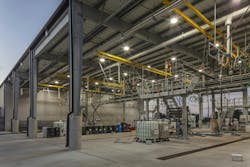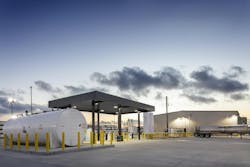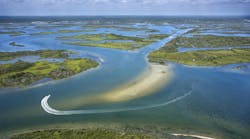Innovative stormwater management maximizes usable space without sacrificing environmental protection
What to know
-
Land-saving design: Sprint Transport’s new $40M facility in La Porte, Texas faced a challenge—traditional detention ponds would take up 5 acres of valuable industrial land.
-
Flow-through innovation: Design-build firm KDW, with engineer Azim Shahparnia and Harris County Flood Control District, developed a novel flow-through stormwater system that removed the need for conventional detention.
-
Regulatory first: The solution not only met but exceeded environmental standards, earning approval and setting a new precedent for industrial developments in high-value urban areas like Houston.
The challenge: Balancing space utilization and stormwater management
The specs for Sprint Transport’s new 30-acre bulk liquid trailer storage and cleaning facility required a four-story office building, a 12-bay maintenance facility, an eight-bay tank wash building, fuel stations and extensive paved storage areas for its fleet of 6,000 to 7,000-gallon road barrel trailers. The surrounding area would require extensive concrete-paved areas for truck and trailer storage, including specialized zones rated for large-reach stacker forklifts and ISO container storage.
Given the high value of industrial property near the Houston Ship Channel and Sprint Transport’s operational requirements, losing up to 17% of the site to detention infrastructure posed financial and operational challenges.
"The traditional approach would have significantly limited the operational capacity of the facility," said Todd Hlavinka, project manager. "We needed to find a solution that met stormwater management requirements while preserving every possible square foot for Sprint Transport’s expanding operations."
Site analysis and regulatory collaboration
The breakthrough came through careful analysis of the site's location in conjunction with its civil engineering partner. The team recognized that the site's proximity to the lower San Jacinto Bay presented an opportunity to reimagine stormwater management entirely.
Rather than containing and slowly releasing stormwater, they proposed routing all stormwater to the northeast corner of the property, where it would discharge into an existing drainage ditch that flows directly into the bay. The solution represented a fundamental shift from containment-based to flow-through stormwater management.
While the approach required extensive coordination with Harris County Flood Control District and other regulatory bodies to ensure compliance with all environmental protection standards, it eliminated the need for a land-robbing detention pond while maintaining rigorous environmental controls.
Engineered environmental protection systems
The elimination of traditional detention infrastructure did not compromise environmental protection. Instead, KDW implemented a comprehensive system of engineered controls designed specifically for the site's industrial applications and environmental sensitivities.
All stormwater inlets throughout the facility feature permanent Fabco Inlet Baskets, industrial-grade filtration systems that remove trash, debris, and potential contaminants before water enters the drainage system. These inlet protection devices provide the first line of defense against pollutants reaching the San Jacinto Bay ecosystem and are routinely cleaned every four to six weeks.
The centerpiece of the environmental protection system is a gate valve located at the northeast corner of the property, creating complete containment capability for the entire site. This valve system transforms the facility into a temporary retention basin when needed, capable of holding stormwater even during a 100-year flood event.
"The gate valve system provides us with complete control over any potential environmental releases," notes Hlavinka. "The trailers are empty when they arrive at the site, but if even a trace of contamination is detected, we can immediately isolate the area, allowing time for testing and treatment before any release to the bay."
Full containment design philosophy
Beyond stormwater management, the facility incorporates comprehensive containment systems for all operational areas. All trailer storage zones feature complete containment infrastructure, ensuring that any potential leaks from the thousands of gallons of various liquids transported through the facility remain within the site boundaries.
This containment-first approach extends throughout the facility design. The tank wash building, where Sprint Transport's Trident Tank Wash division cleans both company and third-party trailers, incorporates complete liquid recovery systems. Maintenance areas include oil-water separators and specialized drainage designed to capture and treat any operational fluids.
The final check is the gate valve that ensures any hazardous materials can be contained, tested and properly treated before release.
Sustainable resource utilization
The facility design incorporates an added environmental bonus: the site utilizes steam generated as a byproduct from an adjacent industrial plant for tank cleaning operations. By integrating waste heat recovery, the team eliminated the need for separate boiler operations, reducing both energy consumption and emissions while improving operational efficiency.
"The idea to use steam for cleaning came together toward the end of the project, thanks to the creativity and commitment of the team and Sprint’s ownership,” Hlavinka said. “We were already accustomed to thinking outside the box, so the ideas just kept coming."
Measurable environmental and economic benefits
The flow-through stormwater management solution delivered clear economic and environmental value. Eliminating the detention pond preserved 3 – 5 acres of prime operational space, allowing Sprint Transport to expand its paved storage areas and maximize land use, translating to millions of dollars in added functionality and long-term value.
The engineered system also enhances environmental protection beyond what traditional detention can offer. Full site isolation during potential contamination events gives operators complete control, preventing harmful discharges into the bay. Continuous inlet filtration captures debris and pollutants from everyday runoff, ensuring both immediate containment and ongoing water quality preservation.
Industry impact and future applications
The Sprint Transport facility offers a compelling model for stormwater management in high-value industrial zones. By eliminating the need for a detention pond and integrating engineered controls, KDW demonstrated that performance, regulatory compliance, and operational efficiency can coexist without sacrificing environmental protection.
Since its completion, the system has performed reliably during both routine and extreme weather events. Its inlet protection systems and gate valve provide active, real-time control over runoff and contamination risks, earning regulatory confidence and industry attention. The project has sparked interest from other developers planning in space-constrained or environmentally sensitive areas.
The project also reinforces the value of public-private collaboration. By engaging regulators early, the team designed a solution for its client – and set a precedent for future industrial development.
About the Author
Rolf Scheffler
Rolf Scheffler is the Chief Operating Officer at Houston-based design-build firm KDW, where he previously served as a Project Manager for more than 18 years. He earned a Bachelor’s Degree in Construction Science from Texas A&M University.




